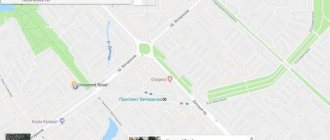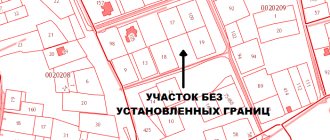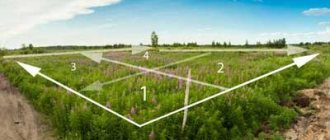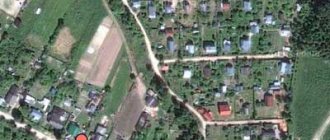Finding out coordinates on a map is necessary in different situations. For example, if you are lost in the forest or in an unfamiliar city. It will be much easier to help you if the location is known. We'll tell you how to find out your coordinates.
The easiest way to do this is using your smartphone on IOS or Android. Using the GPS module, the phone will easily determine your geoposition. Special programs will help him with this, which we will discuss below. Before proceeding with any of the methods, be sure to turn on the geolocation mode , otherwise your location may be determined with a large error!
Determining geographic coordinates and plotting objects on a map using known coordinates
(Article: 2. Determining geographic coordinates and plotting objects on a map using known coordinates)
The geographic coordinates of a point located on the map are determined from the nearest parallel and meridian, the latitude and longitude of which are known.
The topographic map frame is divided into minutes, which are separated by dots into divisions of 10 seconds each. Latitudes are indicated on the sides of the frame, and longitudes are indicated on the northern and southern sides.
Rice. 3. Determining the geographic coordinates of a point on the map (point A) and plotting the point on the map according to geographic coordinates (point B) Using the minute frame of the map, you can:
1. Determine the geographic coordinates of any point on the map.
For example, the coordinates of point A (Fig. 3). To do this, you need to use a measuring compass to measure the shortest distance from point A to the southern frame of the map, then attach the meter to the western frame and determine the number of minutes and seconds in the measured segment, add the resulting (measured) value of minutes and seconds (0'27") with the latitude of the southwestern corner of the frame - 54°30′.
Latitude
points on the map will be equal to: 54°30'+0'27" = 54°30'27".
Longitude
is defined similarly.
Using a measuring compass, measure the shortest distance from point A to the western frame of the map, apply the measuring compass to the southern frame, determine the number of minutes and seconds in the measured segment (2'35"), add the resulting (measured) value to the longitude of the southwestern corner frames - 45°00′.
Longitude
points on the map will be equal to: 45°00'+2'35" = 45°02'35"
2. Plot any point on the map according to the given geographic coordinates.
For example, point B latitude: 54°31 '08", longitude 45°01 '41".
To plot a point in longitude on a map, it is necessary to draw the true meridian through this point, for which you connect the same number of minutes along the northern and southern frames; To plot a point in latitude on a map, it is necessary to draw a parallel through this point, for which you connect the same number of minutes along the western and eastern frames. The intersection of two lines will determine the location of point B.
How can you find latitude and longitude?
Using the basic definitions described in the previous sections, you can easily find longitude and latitude on a paper map or globe. Determine in what part of the globe the point you are looking for is located. Find the latitude first, then the longitude. This is the order most often used when writing coordinates and searching for them. Almost all geographical maps have a coordinate grid with numerical values of degrees of parallels of latitude and longitude. Use them to locate the desired location on the map.
When searching for in-depth and 3D coordinates, height is sometimes used. But it does not apply to geographical concepts. And the coordinates are not listed in the record. Moreover, today everyone has laptops and mobile devices, with the help of which you can easily find any point on the map, having its coordinates and even without knowledge of basic geographical concepts.
Determination of rectangular coordinates of points. Drawing points on a map by their coordinates
(Article: 4. Determination of rectangular coordinates of points. Drawing points on a map according to their coordinates)
Using a coordinate grid using a compass (ruler), you can:
1. Determine the rectangular coordinates of a point on the map.
For example, points B (Fig. 2).
To do this you need:
- write down X - digitization of the lower kilometer line of the square in which point B is located, i.e. 6657 km;
- measure the perpendicular distance from the bottom kilometer line of the square to point B and, using the linear scale of the map, determine the size of this segment in meters;
- add the measured value of 575 m with the digitization value of the lower kilometer line of the square: X=6657000+575=6657575 m.
The Y ordinate is determined in the same way:
- write down the Y value - digitization of the left vertical line of the square, i.e. 7363;
- measure the perpendicular distance from this line to point B, i.e. 335 m;
- add the measured distance to the Y digitization value of the left vertical line of the square: Y=7363000+335=7363335 m.
2. Place the target on the map at the given coordinates.
For example, point G at coordinates: X=6658725 Y=7362360.
To do this you need:
- find the square in which point G is located according to the value of whole kilometers, i.e. 5862;
- set aside from the lower left corner of the square a segment on the map scale equal to the difference between the abscissa of the target and the bottom side of the square - 725 m;
- From the obtained point, along the perpendicular to the right, plot a segment equal to the difference between the ordinates of the target and the left side of the square, i.e. 360 m.
Rice. 2. Determining the rectangular coordinates of a point on the map (point B) and plotting the point on the map using rectangular coordinates (point D)
Entertaining geodesy
Hi all! Today I will tell you, %USERNAME%, about shoes and sealing wax, cabbage, king coordinates, projections, geodetic systems and just a little about web cartography. Make yourself comfortable. As Arthur C. Clarke said, any sufficiently developed technology is indistinguishable from magic. It’s the same in web cartography - I think everyone has long been accustomed to using geographic maps, but not everyone understands how it all works.
Here is a seemingly simple thing - geographical coordinates. Latitude and longitude, what could be simpler. But imagine that you find yourself on a desert island. The smartphone has drowned, and you have no other means of communication. All that remains is to write a letter asking for help and throw it into the sea in a sealed bottle the old fashioned way.
The only problem is that you don’t know at all where your uninhabited island is, and without indicating the coordinates, no one will find you, even if they catch your letter. What to do? How to determine coordinates without GPS?
So, a little theory first. To assign coordinates to points on the surface of a sphere, it is necessary to set a reference point - a fundamental plane for measuring latitudes and a prime meridian for measuring longitudes. For the Earth, the equatorial plane and the Greenwich meridian are usually used, respectively.
Latitude (usually denoted φ) is the angle between the direction to a point from the center of the sphere and the fundamental plane. Longitude (usually denoted θ or λ) is the angle between the plane of the meridian passing through a point and the plane of the prime meridian.
How to determine your latitude, i.e. the angle between the plane of the earth's equator and the point where you are?
Let's look at the same drawing from a different angle, projecting it onto the plane of our meridian. Let’s also add a horizon plane to the drawing (a tangent plane to our point):
We see that the desired angle between the direction to the point and the equatorial plane is equal to the angle between the horizon plane and the Earth’s rotation axis.
So how do we find this angle? Let's remember the beautiful pictures of the starry sky with a long shutter speed:
This point in the center of all the circles described by the stars is the celestial pole. By measuring its height above the horizon, we obtain the latitude of the observation point.
The question remains of how to find the celestial pole in the starry sky. If you are in the Northern Hemisphere, then everything is quite simple:
— find the Ursa Major bucket; - mentally draw a straight line through the two outermost stars of the bucket - Dubhe and Merak; - this straight line will point you to the handle of the Ursa Minor bucket. The extreme star of this pen - Polaris - almost exactly coincides with the North Pole of the world.
The polar star is always in the north, and its height above the horizon is equal to the latitude of the observation point. If you manage to get to the North Pole, the North Star will be directly above your head.
In the Southern Hemisphere, things are not so simple. There are no large stars near the south pole of the world, and you will have to find the constellation Southern Cross, mentally extend down its larger crossbar and count 4.5 of its length - somewhere in this area the south pole of the world will be located.
The constellation itself is easy to find - you have seen it many times on the flags of different countries - Australia, New Zealand and Brazil, for example.
We decided on the latitude. Let's move on to longitude. How to determine longitude on a desert island?
In fact, this is a very difficult problem, because, unlike latitude, the reference point for longitude (prime meridian) is chosen arbitrarily and is not tied to any observable landmarks. In 1567, the Spanish King Philip II offered a substantial reward to anyone who proposed a method for determining longitude; in 1598, under Philip III, it grew to 6 thousand ducats at a time and 2 thousand ducats of annuity for life - a very decent amount at that time. The problem of determining longitude has been a fixation of mathematicians for several decades, like Fermat's theorem in the 20th century.
As a result, longitude began to be determined using this device:
In fact, this device remains the most reliable way to determine longitude (not counting GPS/GLONASS) today. This instrument... (drum roll)... marine chronometer.
In fact, when longitude changes, the time zone changes. Based on the difference between local time and Greenwich time, it is easy to determine your own longitude, and very accurately. Each minute of time difference corresponds to 15 arc minutes of longitude.
Accordingly, if you have a watch set to Greenwich time (in fact, it doesn’t matter which one - it’s enough to know the time zone of the place where your watch is set) - do not rush to change it. Wait until local noon and the time difference will tell you the longitude of your island. (It is very easy to determine the moment of noon - watch the shadows. In the first half of the day, the shadows shorten, in the second they lengthen. The moment when the shadows began to lengthen is astronomical noon in the area.)
Both methods of determining coordinates, by the way, are well described in Jules Verne’s novel “The Mysterious Island.”
So, we were able to determine our latitude and longitude with an error of several degrees, i.e. a couple of hundred kilometers. For a note in a bottle, such precision may still be enough, but for geographical maps it is no longer enough.
Part of this error is due to the imperfection of the tools used, but there are other sources of error. The Earth can be considered a sphere only as a first approximation - in general, the Earth is not a sphere at all, but a geoid - a body most similar to a highly uneven ellipsoid of rotation. In order to accurately assign coordinates to each point on the earth's surface, rules are needed - how to project a specific point on the geoid onto the sphere.
Such a set of rules must be universal for all geographical maps in the world - otherwise the same coordinates will indicate different points on the earth’s surface in different systems. Currently, almost all geographic services use a single system for assigning coordinates to points - WGS 84 (WGS = World Geodetic System, 84 is the year the standard was adopted).
WGS 84 defines the so-called reference ellipsoid is a surface to which coordinates are reduced for ease of calculation. The parameters of this ellipsoid are as follows:
— semimajor axis (equatorial radius): a = 6378137 meters; - compression: f = 1 / 298.257223563.
From the equatorial radius and compression, we can obtain the polar radius, also known as the semiminor axis (b = a * (1 - f) ≈ 6356752 meters).
Any point on the earth’s surface is thus assigned three coordinates: longitude and latitude (on the reference ellipsoid) and height above its surface. In 2004, WGS 84 was supplemented by the Earth Gravitational Model (EGM96) standard, which clarifies the sea level from which elevations are measured.
It is interesting that the prime meridian in WGS 84 is not Greenwich at all (passing through the axis of the passage instrument of the Greenwich Observatory), but the so-called. IERS Reference Meridian, which passes 5.31 arcseconds east of Greenwich.
Let's say we have learned to determine our coordinates. Now you need to learn how to display the accumulated geographical knowledge on the monitor screen. Well, here’s the thing: there aren’t very many spherical monitors in the world (not to mention geoid-shaped monitors). We need to somehow display the map on a plane - project it.
One of the simplest ways is to project a sphere onto a cylinder, and then unfold this cylinder onto a plane. Such projections are called cylindrical; their characteristic property is that all meridians are displayed on the map as vertical lines.
One can think of many projections of a sphere onto a cylinder. The most famous of the cylindrical projections is the Mercator projection (named after the Flemish cartographer and geographer Gerard Kremer, better known under the Latinized surname Mercator, who widely used it in his maps).
Mathematically, it is expressed as follows (for a sphere):
x = R λ; y = R ln(tg(π/4 + φ/2), where R is the radius of the sphere, λ is longitude in radians, φ is latitude in radians.
The output is the usual Cartesian coordinates in meters.
A map in Mercator projection looks like this:
It is easy to notice that the Mercator projection very significantly distorts the shapes and areas of objects. For example, Greenland on the map occupies twice the area of Australia - although in reality Australia is 3.5 times larger than Greenland.
What is so good about this projection that it has become so popular despite significant distortions? The fact is that the Mercator projection has an important characteristic property: it preserves angles when projected.
Let's say we want to sail from the Canary Islands to the Bahamas. Let's draw a straight line on the map connecting the points of departure and arrival.
Since all meridians in cylindrical projections are parallel, and the Mercator projection also preserves angles, our line will intersect all meridians at the same angle. This means that it will be very easy for us to sail along this line: it is enough to maintain the same angle throughout the entire journey between the ship’s course and the direction to the polar star (or the direction to magnetic north, which is less accurate), and the desired angle can be easily measure with a banal protractor.
Similar lines that intersect all meridians and parallels at the same angle are called rhoxodromes. All rhoxodromes in the Mercator projection are depicted straight on the map, and it is this remarkable property, extremely convenient for sea navigation, that has brought the Mercator projection wide popularity among sailors.
It should be noted that what has been said is not entirely true: if we project a sphere and move along the geoid, then the path angle will not be determined entirely correctly and we will not arrive exactly there. (The discrepancy can be quite noticeable - after all, the equatorial and polar radii of the Earth differ by more than 20 kilometers.) An ellipsoid can also be projected while preserving the angles, although the formulas for the elliptical Mercator projection are much more complicated than for the spherical one (the inverse transformation is not expressed at all in elementary functions). A complete and detailed description of the mathematics of the Mercator projection on an ellipsoid can be found here.
When we started making our own maps at Yandex, it seemed logical to us to use the elliptical Mercator projection. Unfortunately, many other web mapping services do not think so and use a spherical projection. Therefore, for a long time it was impossible to show tiles, say, OSM, on top of the Yandex map - they diverged along the y-axis, the closer to the pole, the more noticeable. In version API 2.0, we decided not to swim against the tide, and provided the ability to both work with the map in an arbitrary projection, and display several layers on the map simultaneously in different projections - whichever is more convenient.
Traveling around the Loxodrome is very simple, but this simplicity comes at a cost: the Loxodrome will send you on a journey along a suboptimal route. In particular, the path along the parallel (if it is not the equator) is not the shortest!
In order to find the shortest path on a sphere, you need to draw a circle with its center at the center of the sphere, passing through these two points (or, what is the same, intersect the sphere with a plane passing through the two points and the center of the sphere).
It is impossible to project a sphere onto a plane in such a way that the shortest paths become straight segments; The Mercator projection, of course, is no exception, and the orthodromes in it look like highly distorted arcs. Some paths (through the pole) cannot be depicted correctly in the Mercator projection:
This is roughly how the shortest route from Anadyr to Cardiff is projected: first we fly into infinity due north, and then return from infinity due south.
In the case of motion on a sphere, the shortest paths are constructed quite simply using the apparatus of spherical trigonometry, but in the case of an ellipsoid the task becomes significantly more complicated - the shortest paths are not expressed in elementary functions.
(I note that this problem, of course, is not solved by choosing a spherical Mercator projection - the construction of shortest paths is carried out on the WGS 84 reference ellipsoid and does not depend in any way on the projection parameters.)
During the development of the Yandex.Maps API version 2.0, we were faced with a difficult task - to parameterize the construction of shortest paths so that: - we could easily use the built-in functions for calculating shortest paths on the WGS 84 ellipsoid; — you could easily set your own coordinate system with your own methods for calculating shortest paths.
After all, the Maps API can be used not only to display maps of the earth’s surface, but also, say, the surface of the Moon or some game world.
To construct shortest paths (geodesic lines), in the general case, the following simple and unpretentious equation is used:
Here - the so-called Christoffel symbols expressed in terms of partial derivatives of the fundamental metric tensor.
It seemed to us somewhat inhumane to force the user to parameterize their mapping area in THIS way :).
Therefore, we decided to take a different path, closer to the Earth and the needs of our users. In geodesy, the problem of constructing shortest paths is the so-called. the first (direct) and second (inverse) geodetic problems.
Direct geodetic problem: given the starting point, the direction of movement (usually the path angle, i.e. the angle between the direction north and the direction of movement) and the distance traveled. You need to find the end point and the end direction of movement.
Inverse geodetic problem: given two points. You need to find the distance between them and the direction of movement.
Note that the direction of travel (path angle) is a continuous function that changes along the entire path.
Having at our disposal the functions for solving these problems, we can use them to solve the cases we need in the Maps API: calculating distances, displaying shortest paths and constructing circles on the earth's surface.
We have declared the following interface for custom coordinate systems:
solveDirectProblem(startPoint, direction, distance) - Solves the so-called first (direct) geodetic problem: where we will end up if we leave the specified point in the specified direction and walk the specified distance without turning.
solveInverseProblem(startPoint, endPoint, reverseDirection) - Solves the so-called second (inverse) geodetic problem: build the shortest route between two points on the mapped surface and determine the distance and direction of movement.
getDistance(point1, point2) - returns the shortest (along a geodetic line) distance between two given points (in meters).
(The getDistance function is provided separately for cases where calculating distances can be done much faster than solving the inverse problem.)
This interface seemed to us quite simple to implement in cases where the user maps some non-standard surface or uses non-standard coordinates. For our part, we wrote two standard implementations - for the usual Cartesian plane and for the WGS 84 reference ellipsoid. For the second implementation we used Vincenty's formulas. By the way, runawayed directly implemented this logic, we say hello to him :).
All these geodetic capabilities are available in the Yandex.Maps API starting from version 2.0.13. Welcome!
Accuracy of determining coordinates on maps of various scales
(Article: 5. Accuracy of determining coordinates on maps of various scales)
The accuracy of determining geographic coordinates using 1:25000-1:200000 maps is about 2 and 10”, respectively.
The accuracy of determining the rectangular coordinates of points from a map is limited not only by its scale, but also by the magnitude of errors allowed when shooting or drawing up a map and plotting various points and terrain objects on it
Most accurately (with an error not exceeding 0.2 mm) geodetic points and are plotted on the map. objects that stand out most sharply in the area and are visible from a distance, having the significance of landmarks (individual bell towers, factory chimneys, tower-type buildings). Therefore, the coordinates of such points can be determined with approximately the same accuracy with which they are plotted on the map, i.e. for a map of scale 1:25000 - with an accuracy of 5-7 m, for a map of scale 1:50000 - with an accuracy of 10- 15 m, for a map of scale 1:100000 - with an accuracy of 20-30 m.
The remaining landmarks and contour points are plotted on the map, and, therefore, determined from it with an error of up to 0.5 mm, and points related to contours that are not clearly defined on the ground (for example, the contour of a swamp), with an error of up to 1 mm.
Special cases of point locations
In geometry there are several special cases of point placement. It’s better to remember them so that you can solve problems without hesitation. Here they are:
- If a point lies on the Oy axis, then its abscissa is equal to 0. For example, point C (0, 2).
- If a point lies on the Ox axis, then its ordinate is 0. For example, point F (3, 0).
- The origin is point O. Its coordinates are zero: O (0,0).
- The points of any straight line that are perpendicular to the abscissa axis have the same abscissa.
- The points of any straight line that are perpendicular to the ordinate axis have the same ordinates.
- If a point lies on the x-axis, then its coordinates will look like: (x, 0).
- If a point lies on the ordinate axis, then its coordinates will look like: (0, y).
Problem solving
(Article: 8. Problem solving)
Determining the coordinates of terrain points (objects) and target designation on the map is practiced practically on training maps using previously prepared points (marked objects).
Each student determines geographic and rectangular coordinates (maps objects according to known coordinates).
Methods of target designation on the map are worked out: in flat rectangular coordinates (full and abbreviated), by squares of a kilometer grid (up to a whole square, up to 1/4, up to 1/9 of a square), from a landmark, along the azimuth and range of the target.
How to determine the coordinates of a plot of land using a smartphone
We have all been using GPS navigation for a long time. However, it is worth understanding that telephones operate on a simplified system and do not always reflect the area as it really is. Surely you have encountered at least once the fact that the navigator periodically “goes stupid” and gets lost on the road. The same thing happens when you try to find the desired coordinate on the ground.
In phones, cell towers are usually used to improve accuracy; in fact, this leads to an error of several meters. Of course, if the plot measures tens of hectares, then this deviation is negligible, but if you want to know the area or boundaries of a plot of 5-6 acres, then the difference in fact will be colossal.











